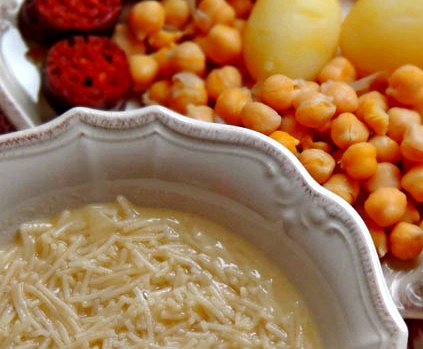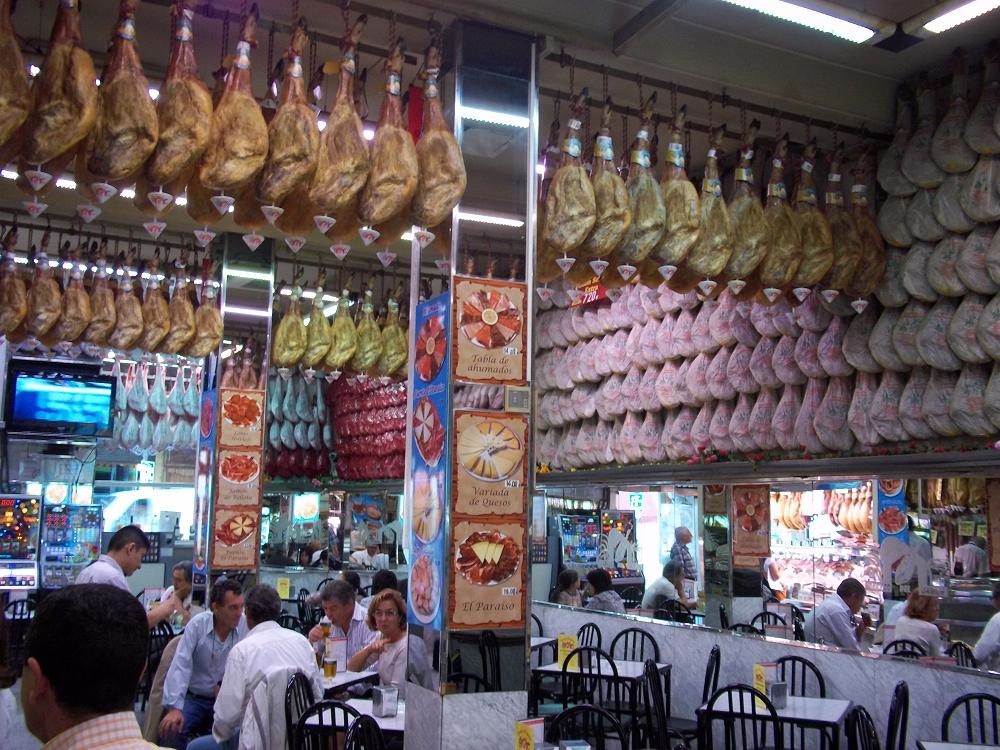Cocido Madrileño
Cocido Madrileño - or simply cocido - is probably one of Spain's national dishes. Cocido is based on a vast cauldron, which simmers away all day, hardly bubbling. In the old days households made it every day, for poached meat used to be the hallmark of the middle-class kitchen. From this pot comes a series of magnificient things.
First there is the caldo. This is clear stock, rich with many meat juices. Famous as clear soup with sherry in it, it is drank world-wide. Caldo is also used in many Spanish dishes. It may be saved, but is often served as the first course before cocido, with a couple of spoonfuls of rice cooked in it.
The most important constituents of the pot are the meats, which are chosen for their diversity. Salt meat, fresh meat and sausage (preferably smoked) must all be there, for this is a dish for tough meats, full of flavour, which are made tender only by long cooking. A roasting chicken is less good than the cheaper boiling hen. Meat bones and trotters add richness to the stock.
The pot also contains vegetables, the first being chickpeas, which are traditdional unifying element in all spanish ollas (stewpots) and have an ancient history in Spain. With them come pot herbs - onion, garlic, and leek - each with their appointed time for being added and function. There are also fresh vegetables, to make colourful, cheerful platters to serve as an entrée to the meats, or as an accompaniment.
- Serves 8
- Difficulty: intermediate
- Preparation time: more than one day. Chickpeas must be soaked overnight, and cooking takes several hours.
Ingredients
- 9 oz dried chickpeas soaked overnight
- 1 lb cured brisket of beef or silverside in one piece
- 9 oz salt pork belly, streaky bacon in one piece or fresh pork belly.
- 1 lb 4 oz knuckle gammon bone, with some meat attached
- 1 1/2 lb beef marrow bone, sawn accross
- 1/2 boiling chicken
- 1 pig's trotter, split
- 1 whole garlic bulb
- 2 bay leaves
- 8 black peppercorns, crushed
- 1 small onion, studded with 2 cloves
- 1 1/2 lb Savoy cabbage, quartered
- 2 carrots, in big pieces
- 2 leeks, short lengths
- 1 lb new potatoes
- 2 chorizos, or other smoked sausage
- 1 morcilla or 7 oz black pudding.
Preparation
Several hours before cooking, cover the salted meat (brisket or silverside, salt pork belly or bacon and gammon knuckle) with cold water and leave to soak.
Choose a large stockpot - at least 10 pints (6 liter). Pack in all the meat, skin side down, with the beef bone. Fit the chicken and trotter on top. Add the garlic bulb, bay leaves and peppercorns and cover with water. Bring to a simmer, sikimming off any scum that rises.
Drain the chickpeas, add to the pot, cover and simmer on the lowest possible heat for 1 1/2 hours, checking occasionally. Halvfway through add the onion stuck with the cloves. No other vegetables go in.
In a second casserole, put the quartered cabbage, all the vegetables and all the sausages. If the black pudding has a plastic skin, remove it. Add water to cover the ingredients and a little salt and bring to a simmer. Cover and cook until the potatoes are ready.
Drain the vegetables and sausages and slice the sausages. Arrange the vegetables decoratively on a platter and put the sausage slices on top. This can be served before the meat or alongside it.
Remove the meats from the main pot, collecting the chickpeas together. Remove the marrow from the bone and slice it into the chickpeas. Slice all the meats. Arrange the meats and chickpeas on a platter, moistening them with a little broth.
Serving cocido
The order and manner of serving is governed by family tradition. Some families like an splendid display, with everything being served at the same time on different platters. This marks the occasion as a feast day, since normal way is for vegetables to precede meat.
Often, and I think more conveniently, the vegetables are served first, garnished with the sausages. The practice has developed, now, of having a second pot for fresh vegetables - in the old days, I suspect, the life was cooked out of them. As the sausages are cooked with them, the second pot retains the cabbage flavours and the smoky sausage taste, which could otherwise reduce the value of the pure meat stock in the main pot.
When the meats, garnished with chickpeas, are served without fresh vegetables, a choice of pickles may be put on the table, gherkins, guindilla, and pickled onions.
You may be also interested in...
See also...
Madrid has always had a magnetic effect on the remaining Spanish regions. Whether due to the fascination for the Court, or to look for work and a better future than that offered in the countryside, over the years this region and the capital of Spain has become a melting pot of people, cultures and gastronomies. Madrid accepts all types of influences from all types of cooking. It does have its own dishes which, although they did not originate in this area, have become "madrileño" over time.




